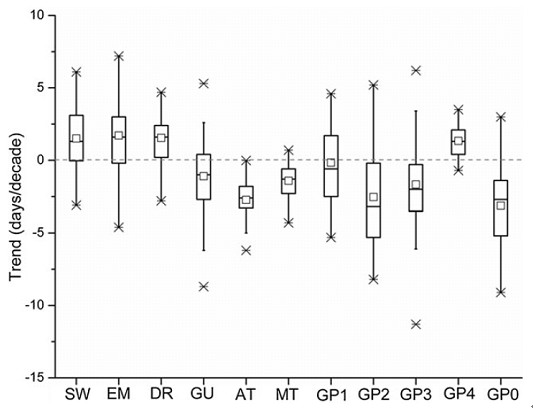Researches show wheat production in China are adapting to ongoing climate change
Based on the wheat phenology observation at more than 100 national agro-meteorological experiment stations across China spanning the years 1981–2007, the research group headed by TAO Fulu in Institute of Geographical Sciences and Natural Resources Research(IGSNRR), Chinese Academy of Sciences investigated the spatiotemporal changes of wheat phenology and seasonal temperature, as well as the correlations between them.
 |
| Trends in winter wheat phenology in the North China Plain for 1981–2009 across the investigated stations. Note that SW is sowing date; EM is emergence date; DR is dormancy date; GU is greenup date; AT is anthesis date; MT is maturity date; GP1 is duration from emergence to dormancy; GP2 is duration from dormancy to greenup; GP3 is duration from greenup to anthesis; GP4 is duration from anthesis to maturity; and GP0 is duration from emergence to maturity (Imaged by TAO Fulu) |
Comparisons of field-observed and crop model-simulated dates of anthesis and maturity suggested that climate change contribute substantially to the shift of wheat phenology, besides the complex influences of agronomic factors. Mean day length during vegetative growing period had a decreasing trend at most of the investigated stations owing to delay of sowing date or/and advancement of heading date, which counterbalanced the roles of temperature in controlling the duration of vegetative growing period. In-depth analyses showed that thermal requirements from sowing to almost each development stage increased, however the thermal requirements to complete each single development stage changed differently, which tended to increase yield and adapt to ongoing climate change.
The findings suggest that climate change impact studies should be strengthened to adequately account for the complex responses and adaptations of field crops to climate change.
Papers
1. Xiao Dengpan, Tao Fulu, Liu Yujie, Shi Wenjiao, et al., 2012. Observed changes in winter wheat phenology in the North China Plain for 1981-2009. International Journal of Biometeorology, http://dx.doi.org/10.1007/s00484-012-0552-8.
2. Tao Fulu, Zhang Shuai, Zhang Zhao. 2012. Spatiotemporal changes of wheat phenology in China under the effects of temperature, day length and cultivar thermal characteristics. European Journal of Agronomy, 43, 201-212.
Download attachments: